Hazrat
Mirza Ghulam Ahmad affirms belief in finality of prophethood
Hazrat Mirza Ghulam Ahmad declared again and
again that his belief is that the Holy Prophet Muhammad is
the Khatam-un-nabiyyin (or Khatam-ul-anbiya),
and that this means that no prophet whatsoever can come
after him. Some such statements are given below. Here
we have quoted only those statements in which he has
specifically used the terms Khatam-un-nabiyyin or
Khatam-ul-anbiya. He has also made other statements,
without reference to this term, again affirming that the Prophet
Muhammad was the Last Prophet after whom no prophet whatsoever
can come.
(Note: English translations of all
his statements are given first, followed by the original
Urdu texts of all the statements. After each English translation,
the reference to the book name is a link leading to the place where the original Urdu text is given.
Similarly, before each Urdu text the reference to the book
name is a link back to its translation .)
| 1. |
In his book Izala Auham, he quotes the
Khatam-un-nabiyyin verse of the Quran (ch. 33, v. 40),
and then translates it into Urdu as follows:
“That is to say, Muhammad is not the father
of any man from among you, but he is the Messenger of Allah,
and the one to end the prophets.”
Here he has translated the term Khatam-un-nabiyyin
as meaning one to end the prophets (Urdu: “khatam
karnai wala hai nabiyon ka”).
He then comments:
“This verse also clearly argues that, after
our Holy Prophet, no messenger shall come into the world.
Therefore, it is proved perfectly manifestly that the Messiah,
son of Mary, cannot return to this world.”
— Izala Auham,
p. 614. Ruhani Khaza’in, vol. 3, p. 431
|
| 2. |
“The Holy Quran does not permit the
coming of any messenger (rasul) after the Khatam-un-nabiyyin,
whether a new one or an old one.”
— Izala Auham,
p. 761. Ruhani Khaza’in, vol. 3, p. 511
|
| 3. |
“The fact that our Holy Prophet is the
Khatam-ul-anbiya also requires the death of Jesus
because if another prophet comes after him, he cannot remain
the Khatam-ul-anbiya, nor can the type of revelation
given to prophets be considered as terminated.… … The return of Jesus is not mentioned anywhere in the Holy
Quran, but the ending of prophethood is mentioned perfectly
clearly. To make a distinction between the coming of an old
prophet [i.e Jesus] and a new prophet is mischievous. Neither
the Hadith nor the Quran make such a distinction, and the
negation contained in the hadith report ‘There is
no prophet after me’ is general. What audacity,
boldness and insolence it is to depart from the clear meaning
of the Quran, in pursuit of one’s feeble conjectures,
and believe in the coming of a prophet after the Khatam-ul-anbiya!.” — Ayyam-us-Sulh,
p. 146. Ruhani Khaza’in, vol. 14, p. 392-393 Here Hazrat Mirza has clearly taken the term Khatam-ul-anbiya
about the Holy Prophet Muhammad to mean that the Prophet Muhammad
was the Last Prophet after whom no prophet at all can come.
|
| 4. |
“ ‘Muhammad is not the father
of any man from among you, but he is the Messenger of Allah,
and the Khatam-un-nabiyyin.’ Do you not know
that the Merciful Lord has declared our Holy Prophet to be
the Khatam-ul-anbiya unconditionally, and our Holy
Prophet has explained this in his words: ‘There
is no prophet after me’, which is a clear explanation
for the seekers of truth? If we consider as allowed the appearance
of a prophet after our Prophet, may peace and the blessings
of Allah be upon him, then we have to allow the opening of
the door of wahy nubuwwat [revelation to prophets] after its closure, and this is clearly wrong, as is not hidden from Muslims.
How can a prophet come after our Prophet when revelation has
been terminated after his death and Allah has ended the prophets
with him?”
— Hamamat-ul-Bushra,
p. 81-82. Ruhani Khaza’in, vol. 7, p. 200
|
| 5. |
“The Holy Prophet had repeatedly said
that no prophet would come after him, and the hadith ‘There
is no prophet after me’ was so well-known that
no one had any doubt about its authenticity. And the Holy
Quran, every word of which is binding, in its verse ‘he
is the Messenger of Allah and the Khatam-un-nabiyyin’,
confirmed that prophethood has in fact ended with our Holy
Prophet. Then how could it be possible that any prophet should
come after the Holy Prophet Muhammad, according to the real
meaning of prophethood? This would have destroyed the entire
fabric of Islam.”
— Kitab-ul-Bariyya,
p. 184, footnote. Ruhani Khaza’in, vol. 13,
pp. 217-218
|
| 6. |
“In brief, God by naming the Holy Prophet
as Khatam-un-nabiyyin in the Quran, and the Holy
Prophet himself by saying ‘There is no prophet after
me’ in Hadith, had settled the matter that no prophet
can come after the Holy Prophet, in terms of the real meaning
of prophethood.”
— Kitab-ul-Bariyya,
p. 185, footnote. Ruhani Khaza’in, vol. 13,
p. 218
|
| 7. |
“By saying ‘There is no prophet
after me’, the Holy Prophet Muhammad closed the
door absolutely to any new prophet or the return of any old
prophet.”
— Ayyam-us-Sulh,
p. 152. Ruhani Khaza’in, vol. 14, p. 400
|
| 8. |
“Someone may raise this objection: ‘Jesus
arose as a prophet of God for the verification of the Torah,
so compared to him what is the worth of your testimony [to
verify the truth of the Quran]. This time too a prophet was
required for a fresh verification.’
The answer to this is that in Islam the door to that prophethood
is closed which establishes its own authority. Allah the Most
High says: ‘He is the Messenger of Allah and the Khatam-un-nabiyyin.’
And it is in the Hadith: ‘There is to be no prophet
after me.’ Besides, the death of Jesus is proved from
conclusive texts; hence there is no hope of his return to
the world. If another prophet were to come, whether new or
old, how could our Holy Prophet remain the Khatam-ul-anbiya?”
— Ayyam-us-Sulh,
p. 74. Ruhani Khaza’in, vol. 14, pp. 308-309
|
| 9. |
“It does not befit God that He should
send a prophet after the Khatam-un-nabiyyin, or that
He should re-start the system of prophethood after having
terminated it.”
— Ainah Kamalat
Islam, p. 377. Ruhani Khaza’in, vol.
5, p. 377
|
| 10. |
“I firmly believe that our Holy Prophet
Muhammad is the Khatam-ul-anbiya, and after him no
prophet shall come for this Muslim people, neither new nor
old.”
— Nishan Asmani,
p. 28. Ruhani Khaza’in, vol. 4, p. 30
|
| 11. |
“The actual fact, to which I testify
with the highest testimony, is that our Holy Prophet is the
Khatam-ul-anbiya, and after him no prophet will come,
neither any old one nor any new one.”
— Anjam Atham,
p. 27, footnote. Ruhani Khaza’in, vol. 11,
p. 27
|
| 12. |
“Similarly, in the verse, ‘This
day I have perfected for you your religion’, and in the verse
‘He is the Messenger of Allah and the Khatam-un-nabiyyin’,
it [the Holy Quran] has clearly ended prophethood with the Holy Prophet Muhammad. And
it has said in plain words that the Holy Prophet is Khatam-ul-anbiya, as it says: ‘He is the Messenger of Allah and the Khatam-un-nabiyyin’. ”
— Tuhfa Golarwiya,
p. 51. Ruhani Khaza’in, vol. 17, p. 174
|
| 13. |
“As our Leader and Messenger, may peace
and the blessings of God be upon him, is the Khatam-ul-anbiya,
and no prophet can come after him, for this reason saints
have been substituted for prophets in this Shari‘ah.”
— Shahadat-ul-Quran,
pages 23-24. Ruhani Khaza’in, vol. 6, pp.
323-324
|
| 14. |
“It should be believed from the bottom
of the heart that prophethood has terminated with the Holy
Prophet Muhammad, as God Almighty says: He is the Messenger
of Allah and the Khatam-un-nabiyyin. To deny this verse,
or to belittle it, is in fact to separate oneself from Islam.
… It should be known that God has ended all His prophethoods
and messengerships with the Holy Quran and the Holy Prophet.”
— Al-Hakam,
17 August 1899, p. 6.
|
| 15. |
“God revealed to me that the true religion is Islam, and the true Messenger is (Muhammad) the Mustafa, the Leader and Imam, who is the Ummi (‘unlettered’) and Amin (‘faithful’). So, just as our Lord is the only One worthy of being worshipped and is One, similarly our Messenger is the only one who is to be followed. There is no prophet after him, and there is no partner with him in being the Khatam an-nabiyyin.”
— Minan-ur-Rahman, see Ruhani Khaza’in, vol. 9, page 164.
|
| 16. |
“Allah is the Being Who … made
Adam and sent messengers and scriptures, and last of all sent
Muhammad, may peace and the blessings of Allah be upon him,
who is the Khatam-ul-anbiya and the best of messengers.” — Haqiqat-ul-Wahy,
p. 141. Ruhani Khaza’in, vol. 22, p. 145 For further references from Haqiqat-ul-Wahy, see
this link. |
After the year 1901
In reply to the quotations presented above, we are told it
was only until the year 1901 that Hazrat Mirza Ghulam Ahmad
held the belief that Khatam-un-nabiyyin (or Khatam-ul-anbiya)
means the Last Prophet after whom no prophet can come, and
that in November 1901 he amended this belief by taking Khatam-un-nabiyyin
to mean ‘best’ but not last Prophet. We have already
quoted above his statement from Haqiqat-ul-Wahy, and
pointed to other references from the same book, showing that
he expressed the same view in this book which was published
in May 1907.
Below we give some further statements after the year 1901
which make clear even to a common reader without much religious
knowledge that Hazrat Mirza considered Khatam-un-nabiyyin
to mean Last of the Prophets.
|
| 17. |
In his book Tazkirat-ush-Shahadatain
(‘The story of two martyrs’), published in 1903,
Hazrat Mirza Ghulam Ahmad goes through the answers that he
gave to various questions while talking to one of those martyrs,
the famous Sahibzada Abdul Latif. At one point he writes:
“I gave him the reply that as the Holy Prophet Muhammad
was the Khatam-ul-anbiya and no prophet was to
come after him…”
— Tazkirat-ush-Shahadatain,
p. 43. Ruhani Khaza’in,
v. 20, p. 45
|
| 18. |
In his Lecture delivered at Ludhiana on 4th November 1905
he stated:
“The Holy Prophet is Khatam-un-nabiyyin
and the Holy Quran is Khatam-ul-kutub.”
— Lecture Ludhiana, p.
37. Ruhani Khaza’in, v. 20, p. 285
Now the term Khatam-ul-kutub for the Holy Quran
does not mean it is “the best but not last” of
the revealed books. All Muslims believe that it brought revealed
books to an end. So Khatam-un-nabiyyin in the same
sentence also means the one who brought prophets to an end.
|
| 19. |
In his book Barahin Ahmadiyya Part 5, which he
began writing in 1905, he criticises his opponents for holding
the mistaken belief that the prophet Jesus will return to
this world again in the last days and he writes that according
to this belief it is Jesus who would be the Khatam-ul-anbiya.
— Barahin Ahmadiyya Part
5, p. 45. Ruhani Khaza’in, v. 21, p. 58.
It is clear here that Khatam-ul-anbiya means only
the last of the prophets, and certainly not the best of prophets.
No Muslim believes that Jesus, by returning, can become the
“best” of the prophets, but he would certainly
become the last if he returned.
|
| 20. |
Again, in the same book he writes that in the books of
the Jews it was written that the the Messiah who would arise
among them:
“would be their Khatam-ul-anbiya”
— Barahin Ahmadiyya
Part 5, p. 120. Ruhani Khaza’in, v. 21,
p. 286.
Here too Khatam-ul-anbiya can only mean the last
of their prophets. The “best” of their prophets
would be their great lawgiver Moses, and not their Messiah
(who was Jesus).
|
| 21. |
In a footnote on the same page as above (Ruhani
Khaza’in, v. 21, p. 286),
Hazrat Mirza Ghulam Ahmad likens himself to Hazrat Abu Bakr,
and writes that they both arose at a time of terrible anxiety
for Islam when Muslims were deserting Islam, and they brought
Muslims back to its fold. By likening himself to Hazrat Abu
Bakr, he shows that he is not a prophet but a khalifa
of the Holy Prophet.
|
| 22. |
Again, in the same book he writes:
“… Isa (Jesus) is the name of the Khatam-ul-anbiya
of the Israelites who came at the end, and Ahmad and Muhammad
are the names of the Khatam-ul-anbiya of Islam…”
— Barahin Ahmadiyya
Part 5, Appendix, page b. Ruhani Khaza’in,
v. 21, p. 412
Jesus being the Khatam-ul-anbiya of the Israelite
prophets means only that he was the last prophet to arise
among them. Therefore the same term used here about the Holy
Prophet means the last of the prophets that was to arise according
to Islam.
It must also be noted that as the Holy Prophet Muhammad was
to be the last prophet ever to arise, it means that his authority
as prophet, and the blessings received through following him,
will continue forever.
|
Urdu texts of the above translations
Images of the original Urdu texts of the above references are shown
below.
1. Izala
Auham, p. 614. Ruhani Khaza’in, vol. 3, p.
431:
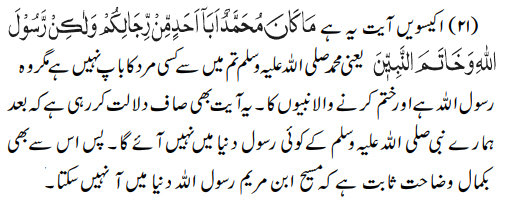
2. Izala
Auham, p. 761. Ruhani Khaza’in, vol. 3, p.
511:

3.
Ayyam-us-Sulh, p. 146. Ruhani Khaza’in, vol.
14, p. 392-393:
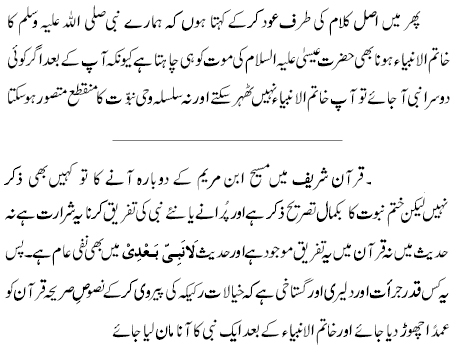
4. Hamamat-ul-Bushra,
p. 81–82. Ruhani Khaza’in, vol. 7, p. 200:
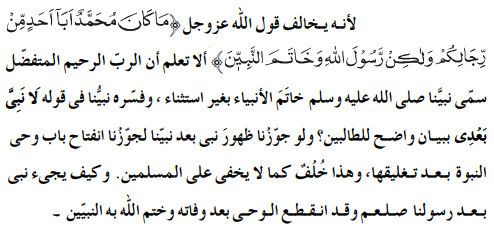
5. Kitab-ul-Bariyya,
p. 184, footnote. Ruhani Khaza’in, vol. 13, pp.
217-218:
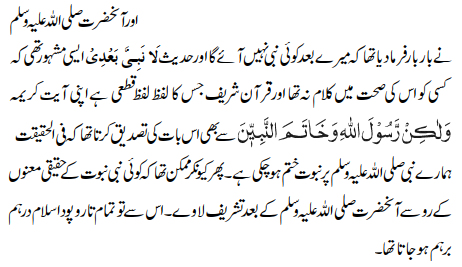
6. Kitab-ul-Bariyya,
p. 185, footnote. Ruhani Khaza’in, vol. 13, p.
218:

7. Ayyam-us-Sulh,
p. 152. Ruhani Khaza’in, vol. 14, p. 400:

8. Ayyam-us-Sulh,
p. 74. Ruhani Khaza’in, vol. 14, pp. 308-309:
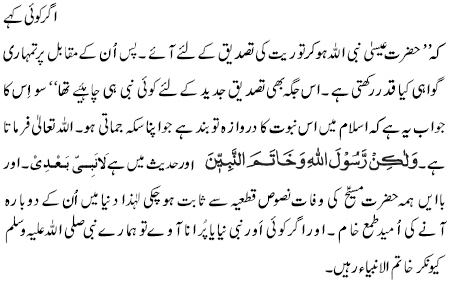
9. Ainah
Kamalat Islam, p. 377. Ruhani Khaza’in, vol.
5, p. 377:

10. Nishan
Asmani, p. 28. Ruhani Khaza’in, vol. 4, p.
30:

11. Anjam
Atham, p. 27, footnote. Ruhani Khaza’in, vol.
11, p. 27:

12. Tuhfa
Golarwiya, p. 51. Ruhani Khaza’in, vol. 17,
p. 174:

13. Shahadat-ul-Quran,
pages 23-24. Ruhani Khaza’in, vol. 6, pp. 323–324:

14. Al-Hakam,
17 August 1899, p. 6:

15. Minan-ur-Rahman, see Ruhani Khaza’in, vol. 9, page 164:

16. Haqiqat-ul-Wahy,
p. 141. Ruhani Khaza’in, vol. 22, p. 145:

For further references from Haqiqat-ul-Wahy, see this link.
17. Tazkirat-ush-Shahadatain,
p. 43. Ruhani Khaza’in, v. 20,
p. 45:

18. Lecture
Ludhiana, p. 37. Ruhani Khaza’in, v. 20,
p. 285:

19. Barahin
Ahmadiyya Part 5, p. 45. Ruhani Khaza’in,
v. 21, p. 58:

20. Barahin
Ahmadiyya Part 5, p. 120. Ruhani Khaza’in,
v. 21, p. 286:

21. Barahin
Ahmadiyya Part 5, p. 120, footnote. Ruhani Khaza’in,
v. 21, p. 286:

22. Barahin
Ahmadiyya Part 5, Appendix, page b. Ruhani
Khaza’in, v. 21, p. 412:

|



















